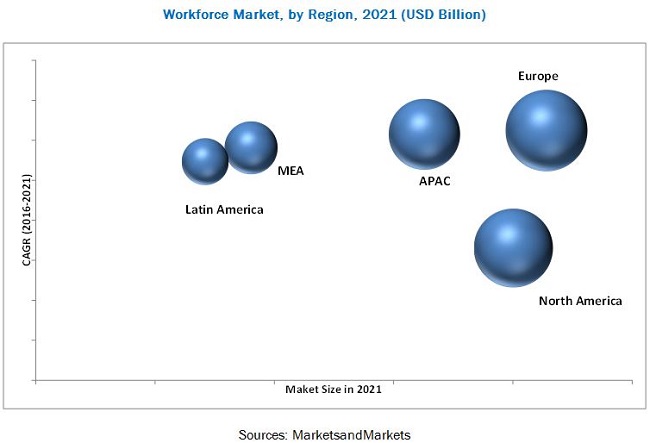According to new market research report "Workforce Management Market by Component (Solutions and Services), Deployment (Cloud and On-premises), Organization Size (SMEs and Enterprises), Vertical, and Region - Global Forecast to 2021", The WFM market size is estimated to grow from USD 4.49 Billion in 2016 to USD 7.37 Billion by 2021, at a Compound Annual Growth Rate (CAGR) of 10.4%. The increased focus on workforce optimization and mobile applications is driving the WFM market.
Know More@ https://www.marketsandmarkets.com/Market-Reports/workforce-management-market-27548173.html

Know More@ https://www.marketsandmarkets.com/Market-Reports/workforce-management-market-27548173.html
In past decades, WFM dealt with finding the right person for the right job at the right time and organizations were heavily focused on scheduling these employees as and when they were needed. It was only about forecasting the actual results and setting up the early warning systems to identify the demands and required changes. Gradually, it started gaining importance due to expansions in the working sector and changing Human Resource (HR) activities. Therefore, WFM solutions started providing organizations with better forecasting and scheduling plans, acquiring real-time information, and planning & managing information effectively for better business plans. These software solutions were used for time and attendance management, compensation management, and performance management.
The Workforce Management market is segmented by component (solutions and services), deployment type, organization size, industry vertical, and region. The services segment is expected to grow at the highest CAGR owing to an increasing number of organizations outsourcing their IT operations to third-party vendors.
The global market has been segmented on the basis of regions into North America, Europe, Asia-Pacific (APAC), Middle East and Africa (MEA), and Latin America to provide a region-specific analysis in the report. Europe is expected to have the largest market share. In Europe, countries such as the U.K. and Germany are accepting and implementing changes in WFM. Compared to other regions, European companies, both private and public, are constantly facing challenges like budget constraints and high competition. They, therefore, require better software and solutions to maximize the efficiency of their workforce. The deployment of cloud is also a driving factor in Europe for the rapid adoption of workforce analytics.

Increasing concerns over employee satisfaction and retention of the best employees drive the growth of WFM market
Consumer Goods and Retail
The consumer goods & retail vertical is evolving and is expected to change rapidly in terms of technology deployment, customer needs, and employment patterns. Retailers need to gain more visibility and control over a diversified and mixed workforce, composed of in-store employees, drivers, and field service providers, both internally and externally. With such complexities, the retail sector needs to focus on employee selection and training, time & attendance, labor analytics, forecasting, and scheduling optimization. WFM solutions help solve these complexities by proper utilization of resources through the power of big data and also provides mobile solutions for budgeting, forecasting, and managing employee tasks.
The WFM ecosystem comprises of solutions and service providers such as IBM (U.S.), Oracle (U.S.), SAP AG (Europe), KRONOS (U.S.), Workforce Software (U.S.), ADP, LLC (U.S.), and WORKDAY (U.S.) among others; who offer their software, solution and services to end users to cater to their unique business requirements. These players are increasingly undertaking mergers and acquisitions, and product launches to develop and introduce new technologies and products in the market.
No comments:
Post a Comment